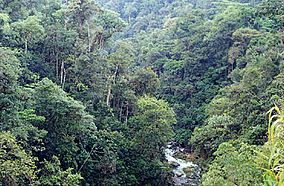Podocarpus National Park facts for kids
Quick facts for kids Podocarpus National Park |
|
|---|---|
|
IUCN Category II (National Park)
|
|

Trees surrounding the Bombuscaro river
|
|
| Location | Ecuador Zamora Chinchipe and Loja |
| Nearest city | Loja, Loja, Ecuador |
| Area | 1462.8 km2 |
| Established | 1982 |
Podocarpus National Park (which means Parque Nacional Podocarpus in Spanish) is a special nature park in the south-east of Ecuador. It was created in 1982 to protect its amazing plants and animals.
This huge park covers about 1,463 square kilometers. That's a lot of land! Most of the park (about 85%) is in the Zamora Chinchipe province, and the rest is in the Loja province. The park stretches from the Andes mountains down to the Nangaritza, Numbala, and Loyola rivers.
Podocarpus National Park is known as a "megadiverse" area. This means it has a super high number of different kinds of plants and animals. It's a unique spot where four different natural systems meet: the Northern Andes, Southern Andes, Amazon, and Pacific regions. Even though scientists have learned a lot about the park, they believe there are still many species waiting to be discovered!
The park has many different types of forests. You can find lower mountain rainforests at about 1,000 meters high. As you go higher, you'll see "elfin forests" at 3,000 meters. These are special forests with small, twisted trees. Even higher, above 3,000 meters, you'll find "paramo" areas. These are like high-altitude grasslands. In the paramo, there are over 100 beautiful lakes, with the Lagunas del Compadre being some of the most famous.
Contents
Visiting Podocarpus National Park
There are two main ways to enter Podocarpus National Park. One entrance is in the Cajanuma Sector, which is about 8 kilometers south of Loja. Here, you can explore the elfin forests and paramo habitats. These areas are high up, between 2,900 and 3,500 meters.
The other main entrance is in the Bombuscaro Sector, near the Bombuscaro River. This area has lower mountain forests, starting at about 1,000 meters high. There are also a couple of other entrances, but they don't have park guards. The Romerillos Sector is one, and Cerro Toledo is another.
The city of Loja is quite close to the park's main entrances. It takes about 25 to 90 minutes to drive from Loja to Cajanuma or Bombuscaro.
Trails for Visitors
Inside the park, you can find different trails to explore. Some are short, like the "Speckled Bear Trail," which takes about 15 minutes. Others are longer, like the "Cloud Forest Trail," which takes about 1 hour and 20 minutes. If you love adventure, there are also longer trails for backpacking and camping. You can also enter the park from the towns of Vilcabamba and Zamora, which are right next to the park.
Amazing Plant Life
Podocarpus National Park is home to an incredible variety of plants. It's even been called the "Botanical Garden of America"! The park has over 4,000 different types of plants.
Important Tree Species
You can find huge trees here, some growing up to 40 meters tall! One important tree is the romerillo (Podocarpus glomeratus). This tree actually gives the park its name! Another very valuable tree is the Cinchona, which is the national tree of Ecuador. The park also has a huge number of different orchids.
Other common plants and trees you might see include:
- chilca (Baccharis sp.)
- laurel
- San Pedro cactus
- uvilla
- black elder
- pumamaqui (Oreopanax sp.)
- sappanwood
- arrayán
- cashoco
- alder
- acacia
- sage
- guato blanco
- cedar
- castor oil plant
- walnut
Wonderful Animal Life
The park is also a haven for many animals. So far, scientists have found 68 different kinds of mammals living in or near the park.
Endangered Mammals
Four of these mammals are on Ecuador's "Red List," meaning they are either endangered or vulnerable. This means they are at risk of disappearing forever. These special animals are:
- Mountain tapir (Tapirus pinchaque)
- Spectacled bear (Tremarctos ornatus)
- Northern pudu (Pudu mephistophiles)
- Jaguar (Panthera onca)
Other interesting mammals you might find include the Amazonian hog-nosed skunk and the common grey shrew opossum.
Birds and Insects
Podocarpus National Park is a paradise for birds! There are 560 different kinds of birds recorded here. That's about 6% of all the birds in the world and 40% of all the birds found in Ecuador! Because of this, it's considered a very important place for protecting birds.
The park is also a hotspot for insects, especially a type of moth called "geometrid moths." More than 1,200 species of these moths have been found in the northern part of the park. This is more than anywhere else in the world!
Climate in the Park
The weather in Podocarpus National Park can change depending on where you are. In the eastern part, the rainy season is from March to July. In the western part, it rains more from October to December.
The temperature also varies. In the higher parts of the park, the average temperature is about 12°C (54°F). In the lower areas, it's warmer, around 18°C (64°F).
See also
 In Spanish: Parque nacional Podocarpus para niños
In Spanish: Parque nacional Podocarpus para niños


